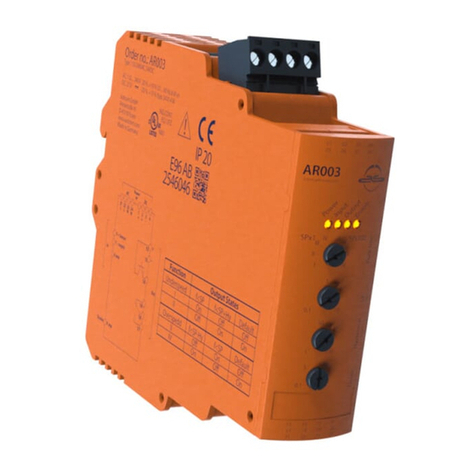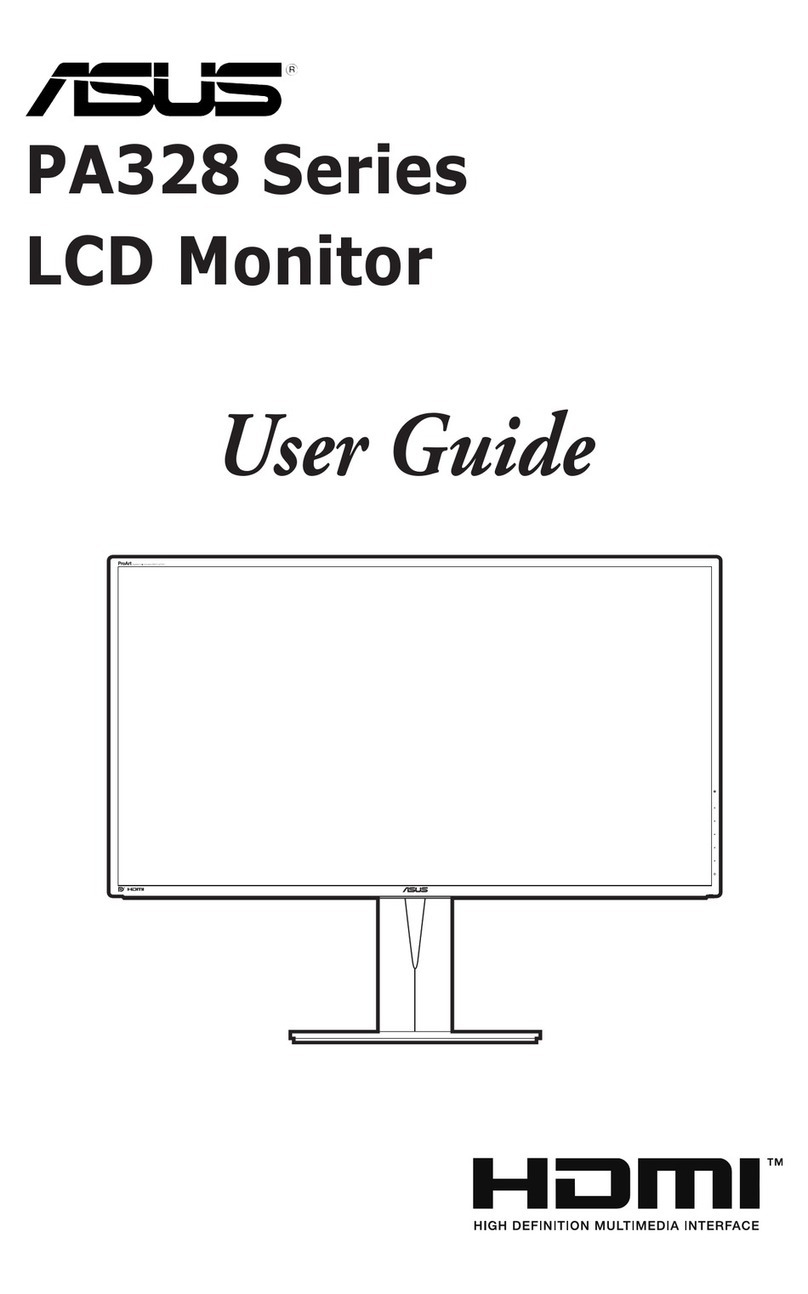autosen AG002 User manual

Operating instructions
Universal display
AG002
EN

AG002 Universal display
2
Contents
1 Preliminary note 3
1.1 Symbols used 3
1.2 Warnings used 3
2Safety instructions 4
3Intended use 5
4Function 6
5Installation 7
6Electrical connection 8
6.1 Wiring 8
6.2 Connection examples 8
6.2.1 Voltage/Current 8
6.2.2 Temperature 10
6.2.3 Frequency / Rotational speed 10
6.2.4 NAMUR 12
6.2.5 Counter 12
7Operating and display elements 13
8Menu 14
8.1 Input type menu 14
8.2 Alarms menu 17
8.3 General menu 18
8.4 Display menu 18
9Parameter setting 19
9.1 Input type 19
9.1.1 Volt/Ampere 19
9.1.2 Pt100(0) 21
9.1.3 Thermo 22
9.1.4 Frequency 22
9.1.5 RPM/Speed 24
9.1.6 Count up / Count down 25
9.2 Alarms 26
9.3 General parameters / Safety parameters – General 28
9.4 Parameters for the indication of measured values – Display 31
9.5 Restore factory settings 32
10 Operation 33
11 Troubleshooting 34
12 Maintenance, repair and disposal 35
13 Factory settings 36
13.1 Input type – Parameters for measuring signals 36
13.2 Alarms – Parameters for alarms A1...A8 40
13.3 General – General parameters / Safety parameters 40
13.4 Display – Parameters for the indication of measured values 41

Universal display AG002
3
1 Preliminary note
You will find instructions, technical data, approvals and further information using the QR code on the
unit / packaging or at www.autosen.com.
1.1 Symbols used
Requirement
Instructions
Reaction, result
[...] Designation of keys, buttons or indications
Cross-reference
Important note
Non-compliance may result in malfunction or interference.
Information
Supplementary note
1.2 Warnings used
ATTENTION
Warning of damage to property
CAUTION
Warning of personal injury
wSlight reversible injuries may result.

AG002 Universal display
4
2 Safety instructions
• The unit described is a subcomponent for integration into a system.
– The system architect is responsible for the safety of the system.
– The system architect undertakes to perform a risk assessment and to create documentation in
accordance with legal and normative requirements to be provided to the operator and user of
the system. This documentation must contain all necessary information and safety instructions
for the operator, the user and, if applicable, for any service personnel authorised by the architect
of the system.
• Read this document before setting up the product and keep it during the entire service life.
• The product must be suitable for the corresponding applications and environmental conditions
without any restrictions.
• Only use the product for its intended purpose (ÒIntended use).
• If the operating instructions or the technical data are not adhered to, personal injury and/or damage
to property may occur.
• The manufacturer assumes no liability or warranty for any consequences caused by tampering with
the product or incorrect use by the operator.
• Installation, electrical connection, set-up, operation and maintenance of the product must be
carried out by qualified personnel authorised by the machine operator.
• Protect units and cables against damage.
• Replace damaged units, otherwise the technical data and safety will be impaired.
• Observe applicable documents.

Universal display AG002
5
3 Intended use
The unit evaluates and displays sensor signals.
The unit is intended for panel mounting. The fixing elements supplied are suited for a wall thickness up
to 6 mm.

AG002 Universal display
6
4 Function
With the unit a wide variety of sensors can be operated and the corresponding physical values are
displayed. If temperatures are to be measured via Pt100, Pt1000 or thermocouple, the temperature
will be displayed in °C or °F (selectable). For measurement inputs such as current, voltage, frequency
or counter, the scaling and indication can be freely selected in the display range from -1999 to 9999.
The unit has two relay outputs which support different operating modes. It can be monitored either via
a threshold value with hysteresis or a window function with alarm range. The switching status of the
relay is visualized. Operation and parameter setting are carried out via four front keys.

Universal display AG002
7
5 Installation
esc
12
96
48
325
Fig. 1: installation
1: sealing
2: fixing element
*Installation depth including connection terminal
The fixing elements supplied are suited for a wall thickness up to 6 mm.
uMake a panel cut-out (92 x 45 mm).
uRemove the fixing elements from the unit.
uInsert the unit into the panel cut-out.
uCheck the seal to make sure it fits securely.
uReinsert the fixing elements into the unit and tighten the 2 clamping screws by hand. Then use a
screwdriver to tighten them another half a turn.
Maximum tightening torque: 0.1 Nm

AG002 Universal display
8
6 Electrical connection
The unit must be connected by a qualified electrician.
uObserve the national and international regulations for the installation of electrical equipment.
uDisconnect power.
uConnect the unit as follows:
6.1 Wiring
10 V, PNP (HTL)
(A)GND, Pt100, Pt1000
0 V DC L-
24 V DC L+
50 mV, TC, Pt100, Reset
1 V, 2 V, mA, Hz, Pt100, Pt1000
1 2 3 4
S1
5678910 11 12
S2
Fig. 2: Wiring
6.2 Connection examples
6.2.1 Voltage/Current
1 2 3 4 11 12
...
-+
L- L+4...20 mAAGND
Fig. 3: 2-wire sensor 4...20 mA
1 2 3 4 11 12
...
-+
-+
L- L+4...20 mAAGND
Fig. 4: 2-wire sensor 4...20 mA with external voltage supply
1 2 3 4 11 12
...
-+
OUT
L- L+0/4...20 mA
UB+
UB-
AGND
Fig. 5: 3-wire sensor 0/4...20 mA
1 2 3 4 11 12
...
-+
-+
L- L+0/4...20 mA
OUT
UB-
UB+
AGND
Fig. 6: 3-wire sensor 0/4...20 mA with external voltage
supply

Universal display AG002
9
1 2 3 4 11 12
...
-+
L- L+0...1 V, 0...2 V
OUT
UB+
UB-
AGND
Fig. 7: 3-wire sensor 0...1 V, 0...2 V
1 2 3 4 11 12
...
-+
-+
L- L+0...1 V, 0...2 V
OUT
UB+
UB-
AGND
Fig. 8: 3-wire sensor 0...1 V, 0...2 V with external voltage
supply
1 2 3 4 11 12
...
-+
L- L+0...10 V
OUT
UB+
UB-
AGND
Fig. 9: 3-wire sensor 0...10 V
1 2 3 4 11 12
...
-+
-+
L- L+0...10 V
OUT
UB+
UB-
AGND
Fig. 10: 3-wire sensor 0...10 V with external voltage supply
1 2 3 4 11 12
...
-+
L- L+0...50 mV
UB+
UB-
OUT+
OUT-
AGND
Fig. 11: 4-wire sensor 0...50 mV
1 2 3 4 11 12
...
-+
-+
L- L+
OUT+
OUT-
UB+
UB-
0...50 mVAGND
Fig. 12: 4-wire sensor 0...50 mV with external voltage
supply
1 2 3 4 11 12
...
-+
L- L+0...1 V, 0...2 V
OUT+
OUT-
UB+
UB-
AGND
Fig. 13: 4-wire sensor 0...1 V, 0...2 V
1 2 3 4 11 12
...
-+
-+
L- L+
OUT+
OUT-
UB+
UB-
0...1 V, 0...2 VAGND
Fig. 14: 4-wire sensor 0...1 V, 0...2 V with external voltage
supply

AG002 Universal display
10
1 2 3 4 11 12
...
-+
L- L+0...10 V
UB+
UB-
OUT+
OUT-
AGND
Fig. 15: 4-wire sensor 0...10 V
1 2 3 4 11 12
...
-+
-+
L- L+0...10 V
UB+
UB-
OUT+
OUT-
AGND
Fig. 16: 4-wire sensor 0...10 V with external voltage supply
6.2.2 Temperature
1 2 3 4
Pt100
11 12
...
-+
L- L+
Fig. 17: Pt100 3-wire
(connection of a 4-wire sensor possible by combining two
conductors connected in the sensor)
1 2 3 4
Pt1000
11 12
...
-+
L- L+
Fig. 18: Pt1000 2-wire
(connection of a 3-wire or 4-wire sensor possible by
combining the conductors connected in the sensor)
1 2 3 4
-+
TC
11 12
...
-+
L- L+
Fig. 19: Thermocouple
6.2.3 Frequency / Rotational speed
1 2 3 4 11 12
...
-+
L- L+
OUT
GND
UB+
UB-
TTL
Fig. 20: Signal transmitter with TTL output
1 2 3 4 11 12
...
-+
-+
L- L+
OUT
UB+
UB-
GND
TTL
Fig. 21: Signal transmitter with TTL output and with external
voltage source

Universal display AG002
11
1 2 3 4 11 12
...
-+
L- L+
OUT
GND
UB+
UB-
PNP
Fig. 22: Signal transmitter with PNP output
1 2 3 4 11 12
...
-+
-+
L- L+
OUT
UB+
UB-
GND
PNP
Fig. 23: Signal transmitter with PNP output and with
external voltage source
Depending on the design of the system, an external resistance circuit can be helpful to reliably detect
higher frequencies.
1 2 3 4 11 12
...
-+
L- L+
OUT
GND
UB+
UB-
PNP
600 Ω
4,2 kΩ
Fig. 24: Signal transmitter with PNP output and external
resistance circuit
1 2 3 4 11 12
...
-+
-+
L- L+
OUT
GND
UB+
UB-
PNP
600 Ω
4,2 kΩ
Fig. 25: Signal transmitter with PNP output, external
resistance circuit and with external voltage source
1 2 3 4 11 12
...
-+
L- L+
OUT
GND
UB+
UB-
NPN
Fig. 26: Signal transmitter with NPN output
1 2 3 4 11 12
...
-+
-+
L- L+
OUT
UB+
UB-
GND
NPN
Fig. 27: Signal transmitter with NPN output and with
external voltage source
Depending on the design of the system, an external resistance circuit can be helpful to reliably detect
higher frequencies.
1 2 3 4 11 12
...
-+
L- L+
OUT
GND
UB+
UB-
NPN
7 kΩ
Fig. 28: Signal transmitter with NPN output and external
resistance circuit
1 2 3 4 11 12
...
-+
-+
L- L+
OUT
7 kΩ
GND
UB+
UB-
NPN
Fig. 29: Signal transmitter with NPN output, external
resistance circuit and with external voltage source

AG002 Universal display
12
6.2.4 NAMUR
The use of NAMUR sensors is possible. However, the wire break and short circuit detection typically
provided by these sensors is not supported.
1 2 3 4 11 12
...
-+
L- L+NAMURGND
NAMUR
Fig. 30: NAMUR sensor
1 2 3 4 11 12
...
-+
-+
L- L+NAMURGND
NAMUR
Fig. 31: NAMUR sensor with external voltage supply
6.2.5 Counter
When used as a counter, use the connection examples for frequency/speed.
The following figure shows the reset input connection.
1 2 3 4 11 12
...
-+
L- L+
GND Reset
Fig. 32: Manual reset with external pushbutton

Universal display AG002
13
7 Operating and display elements
2
3
4
5
1
esc ●
▼
▼
Fig. 33: Operating and display elements
1: [▲] key
2: [▼] key
3: [●] key
4: [esc] key
5: display

AG002 Universal display
14
8 Menu
Press the operating key [●] > 1 s to navigate from the process value display to the main menu and
from there to the submenus. See also Parameter setting (Ò/19).
Process value display
Main menu
Input type
Submenu for selected input type
Alarms
General
Display
run
Fig. 34: Menu overview
Press [run] to exit the menu and return from the parameter setting mode to the operating mode.
8.1 Input type menu
Input type
Alarms
General
run
Display
Input type
Pt100(0)
Thermo
Volt/Ampere
Volt/Ampere
Frequency
RPM/Speed
Count up /
Count down
Main menu
Fig. 35: Menu for input type

Universal display AG002
15
Input type
Alarms
General
run
Display
Volt/Ampere
AAAAAAA…ZZZZZZZ
0...10 V 0...2 V 0...1 V 0...50 mV
0...20 mA 4...20 mA
Sens V (0...10 V) Sens mA (0...20 mA)
-1999…9999
-1999…9999
-1999…9999
-1999…9999
cccc ccc.c cc.cc c.ccc
...
-19.99…99.99 V / mV / mA
-19.99…99.99 V / mV / mA
-19.99…99.99 V / mV / mA
-1999…9999
-19.99…99.99 V / mV / mA
0...9
Volt/Ampere
Scale unit
Analog end
Analog start
Linearization points
Display P#1(Y)
Input range
Decimal point
End value
Start value
Value offset
Analog P#4(X)
Display P#9(Y)
Analog P#9(X)
Back
Main menu
Fig. 36: Menu for input type Volt/Ampere
Input type
Alarms
General
run
Display
Temperature
Volt/Ampere
Sensor type
Scale unit
Adjustment -19.9…19.9 °C (-35.9...35.9 °F)
°C °F
Pt100(0)
Pt100 (200 °C) Pt100 (850 °C) Pt1000 (850 °C)
Back
Main menu
Fig. 37: Menu for input type Pt100(0)
Input type
Alarms
General
run
Display
Temperature
Sensor type
Scale unit
Adjustment -19.9…19.9 °C (-35.9...35.9 °F)
°C °F
Thermo
Type N Type E Type T Type R
Type L Type J Type K Type B Type S
Back
Main menu
Fig. 38: Menu for input type Thermo

AG002 Universal display
16
Input type
Alarms
General
run
Display
Frequency
AAAAAAA…ZZZZZZZ
TTL NPN PNP NAMUR
9.999 Hz
-1999…9999
-1999…9999
cccc ccc.c cc.cc c.ccc
2 Hz 5 Hz 10 Hz 20 Hz 50 Hz 100 Hz 200 Hz 500 Hz No
...
0000…9999 Hz
0000…9999 Hz
-1999…9999
-1999…9999
0000…9999 Hz
-1999…9999
0000…9999 Hz
0...9
Frequency
99.99 Hz 999.9 Hz 9999 Hz
Scale unit
Frequency end
Frequency start
Linearization points
Display P#1(Y)
Input signal
Decimal point
Input range
Value offset
Frequency P#1(X)
Display P#9(Y)
Frequency P#9(X)
End value
Start value
Back
Filter
Main menu
Fig. 39: Menu for input type Frequency
Input type
Alarms
General
run
Display
RPM/Speed
Scale unit AAAAAAA…ZZZZZZZ
Input signal TTL NPN PNP NAMUR
Decimal point
Filter
cccc ccc.c cc.cc c.ccc
2 Hz 5 Hz 10 Hz 20 Hz 50 Hz 100 Hz 200 Hz 500 Hz No
Number of cams
Time base
0001…9999
Second
RPM/Speed
Minute Hour
Back
Main menu
Fig. 40: Menu for input type RPM/Speed

Universal display AG002
17
Input type
Alarms
General
run
Display
Counter
Scale unit AAAAAAA…ZZZZZZZ
Input signal TTL NPN PNP NAMUR
Decimal point
Filter
cccc ccc.c cc.cc c.ccc
2 Hz 5 Hz 10 Hz 20 Hz 50 Hz 100 Hz 200 Hz 500 Hz No
0001…9999
Count up /
Count down
Prescaler
Count base
Active edge Positive Negative
Pulses Seconds Minutes
Reset
End value
End count
-1999…9999
0001…9999
0000…9999
Back
Main menu
Fig. 41: Menu for input type Count up / Count down
8.2 Alarms menu
The parameters for alarms A1...A8 are identical. The following figure only shows the parameters of A1.
A2
A3
A1
A4
A7
A8
A6
A5
A1 hysteresis
A1 upper value
A1 lower value
A1 reset delay
A1 flashing
A1 alarm type
A1 mode Off On Exceed limit
No change Off On
No relay Relay 1 Relay 2
Default Green Red Orange
In windowBelow limit Out of window
A1 setpoint
A1 fault
A1 output sel.
0...100 s
0...100 s
-1999…9999
0000…9999
A1 switching delay
A1 display color
Back
Continuous Flashing
Alarms A1
esc
-1999…9999
-1999…9999
Background Font
Main menu
Fig. 42: Alarms menu

AG002 Universal display
18
8.3 General menu
Input type
...
ADC
0000…9999
0000…9999
-1999…9999
-1999…9999
0...7
General
0...99
01…20
Main menu
Fig. 43: General menu
8.4 Display menu
Display
Main menu
Fig. 44: Display menu

Universal display AG002
19
9 Parameter setting
Parameters can be set before installation or during operation.
If you change parameters during operation, this will influence the function of the plant.
uEnsure that there will be no malfunctions in your plant.
During parameter setting the unit remains in the operating mode. It continues to monitor with the
existing parameter until the parameter setting has been completed.
Depending on the parameter setting, the parameters available in the menu may change.
Parameter setting process in general:
Intention Action
Change from the operating to the parameter setting mode [●] > 1 s
Change to the submenu Press [▼] / [▲] to navigate to the submenu (e.g. “Display”),
then press [●] < 1 s.
Select the requested parameter Press [▼] / [▲] to navigate to the parameter (e.g. “Value font
color”), then press [●] < 1 s.
Modify the parameter value Select parameter value Press [▼] / [▲] to navigate to the parameter value (e.g.
“Green”). Press [●] < 1 s to save the value.
Enter numerical value Press [●] < 1 s to jump to the desired position.
Press [▼] / [▲] to change the value and press [●] > 1 s to
save it.
Enter text Press [●] < 1 s to jump to the desired position.
Press [▼] / [▲] to change the value, long press [▼] / [▲] for
special and lower case letters.
Press [●] > 1 s to save all characters to the left of the select-
ed position. All other characters are removed.
Return to the next higher menu level [esc]
OR
menu item [Back]
Return to the operating mode > 30 seconds (timeout)
OR
press [esc] repeatedly.
OR
From the main menu: menu item [run]
9.1 Input type
The parameter [Input type] defines the type of input signal. The following settings are possible:
Value Description
Volt/Ampere Voltage/current measurement
Pt100(0) Temperature measurement via Pt100 or Pt1000
Thermo Temperature measurement via thermocouple
Frequency Frequency measurement
RPM/Speed Speed measurement
Count up / Count down Counter
Tab. 1: Input type
9.1.1 Volt/Ampere
The unit displays the measured voltage or current value.

AG002 Universal display
20
In addition, it is possible to calibrate the unit via the connected measuring section.
Carry out a calibration (optional):
ü[Input type] [Volt/Ampere] is selected.
uSelect [Input range] and set the desired measuring range:
• Sens V (0...10 V input)
• Sens mA (0…20 mA input)
uSelect [End value] or [Start value].
uEnter the measured value to be displayed at the current input value (analogue value).
uConfirm [Sens.Calib] with [Yes] to start the calibration and accept the current analogue input value
as [Analog start] or [Analog end].
OR
cancel [Sens.Calib] with [no] to use the set [Analog start] or [Analog end] value without any
changes.
Calibration makes it possible to assign the current analogue input value as an [Analog start] or
[Analog end] value to the set [Start value] or [End value].
Example: A distance sensor (4...20 mA) is to determine the drilling depth. Max. drilling depth: 80
mm
ü[Input type] [Volt/Ampere] is selected.
uBring the drill to the surface of the workpiece (0 mm drilling depth).
uSelect [Input range] [Sens mA].
uSelect [Start value].
uEnter 0 as [Start value].
uConfirm [Sens.Calib] with [Yes].
wThe unit assigns the display value 0 to the analogue input value.
uMove the tool 80 mm further (80 mm drilling depth).
uSelect [Sens.Calib].
uSelect [End value].
uEnter 80 as [End value].
uConfirm [Sens.Calib] with [Yes].
wThe unit assigns the display value 80 to the analogue input value.
wIn the operating mode, the unit calculates the drilling depth from the analogue input value
and displays it in mm.
Parameter setting:
ü[Input type] [Volt/Ampere] is selected.
uSelect [Input range] and set the desired measuring range:
• 0…10 V
• 0…2 V
• 0…1 V
• 0...50 mV
• 0...20 mA
• 4...20 mA
uSelect [End value] and set the value displayed at the analogue input value [Analog end]. [Analog
end] is the final value of the measuring range by default, but it can be adjusted.
Table of contents
Other autosen Monitor manuals
Popular Monitor manuals by other brands

Philips
Philips BDL5530EL user manual
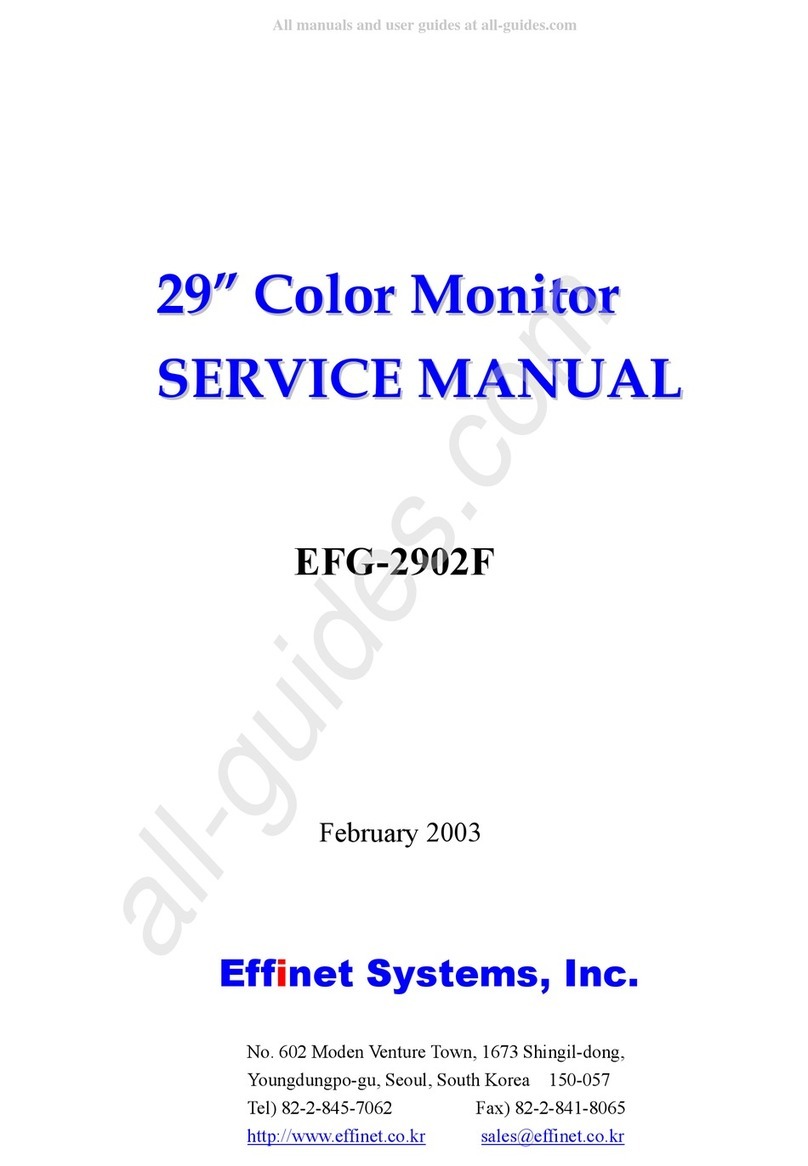
Effinet Systems
Effinet Systems EFG-2902F Service manual
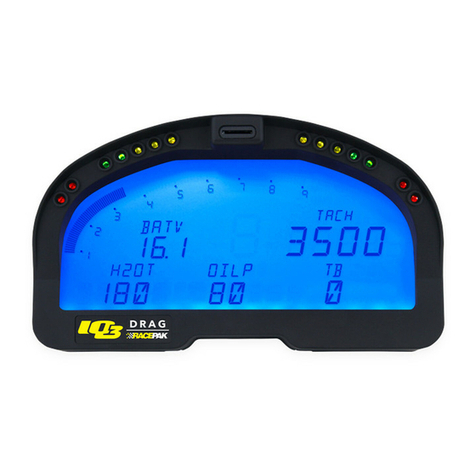
Racepak
Racepak IQ3 Drag Dash installation manual
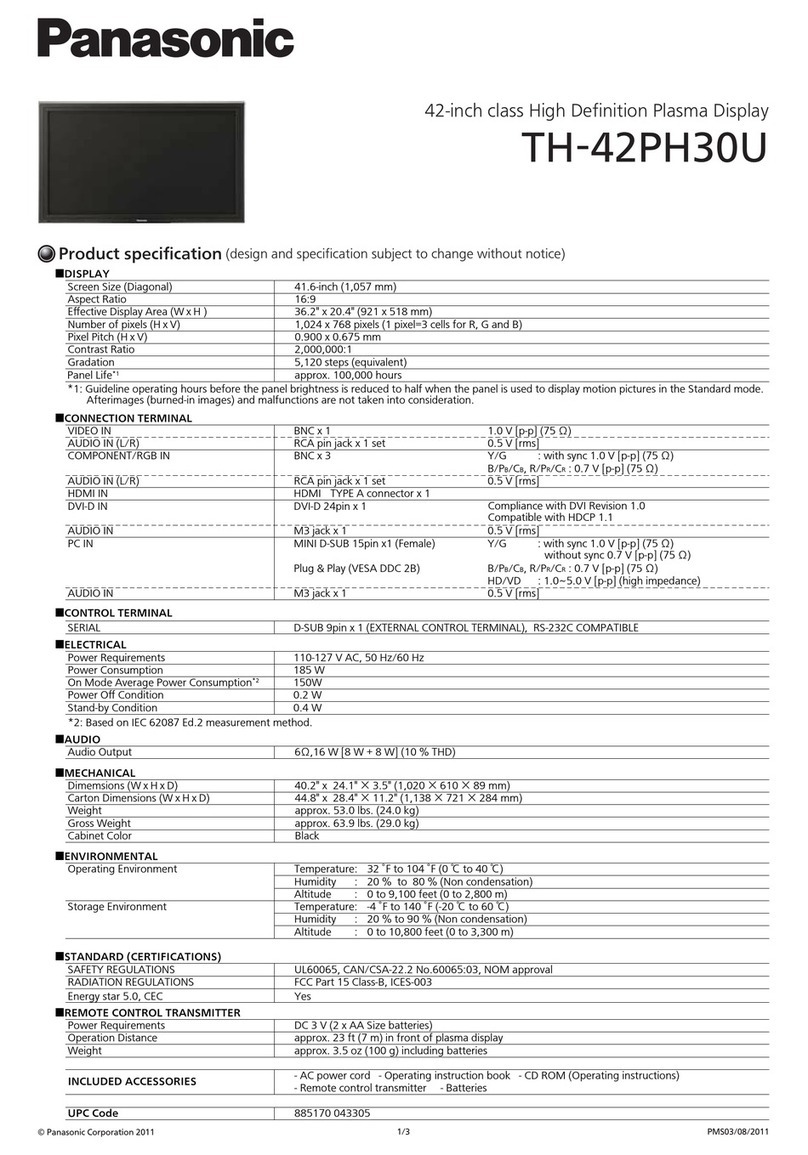
Panasonic
Panasonic TH-42PH30U Specifications
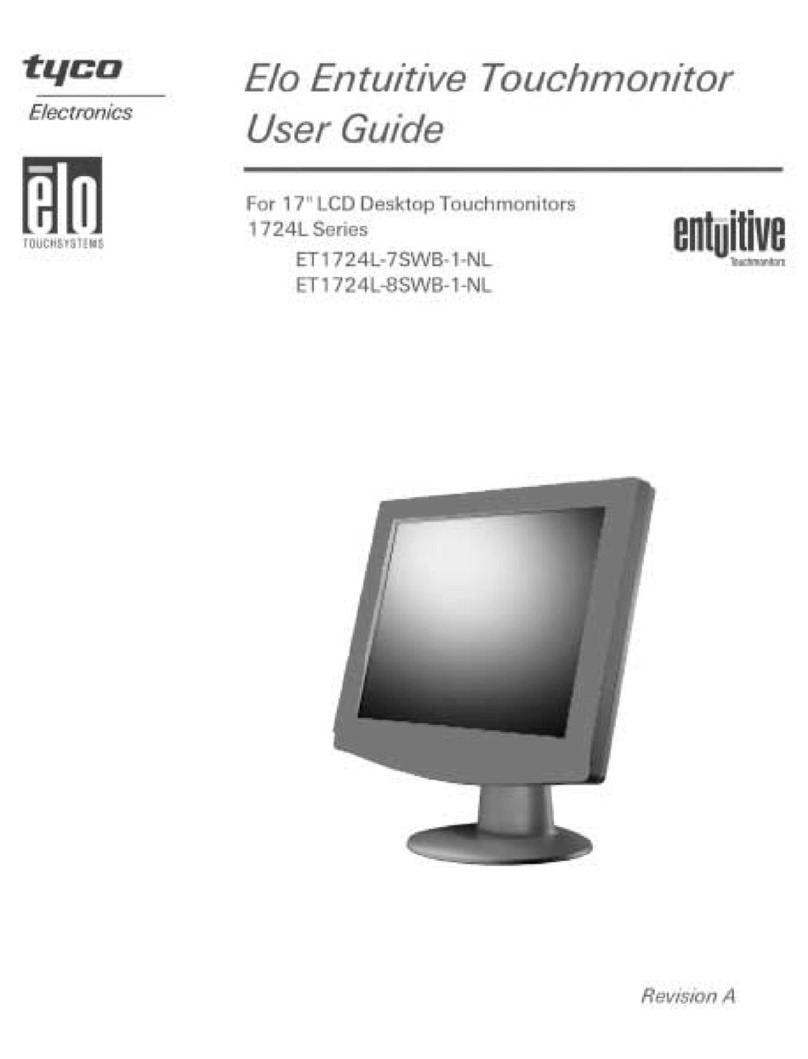
Elo TouchSystems
Elo TouchSystems Entuitive ET1724L-7SWB-1-NL user guide

VarTech Systems
VarTech Systems VT170W user guide
